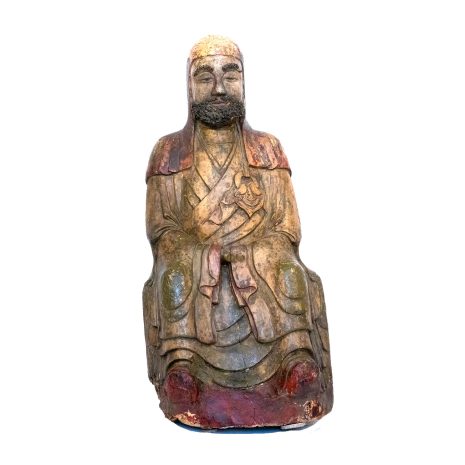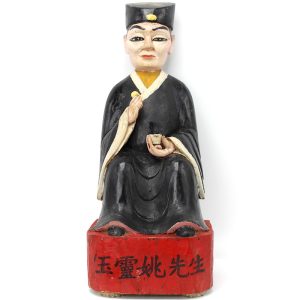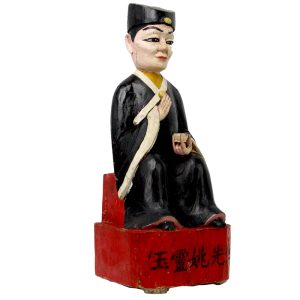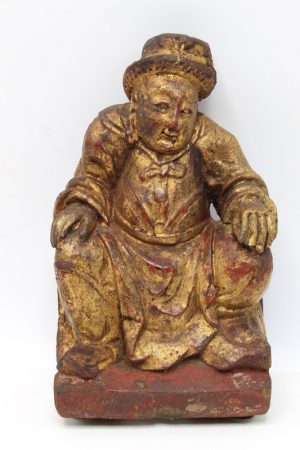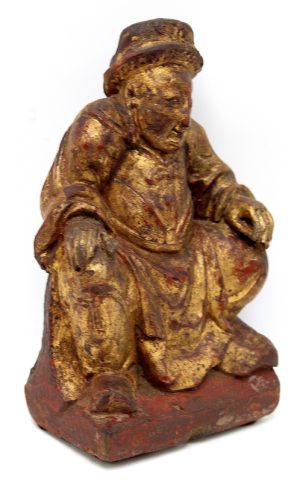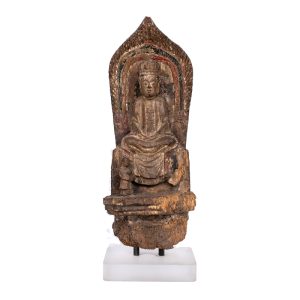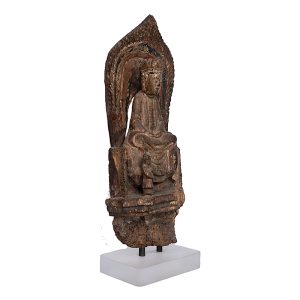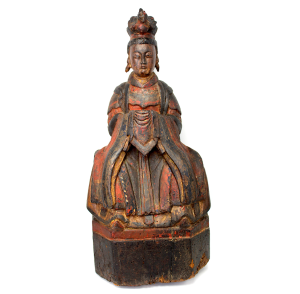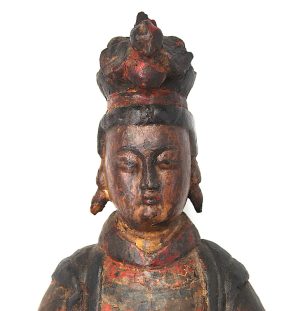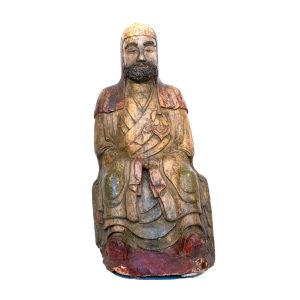Antique Large Lohan, Probably Bodhidharma, China (16436B-WHKE) SPECIAL PRICE
Original price was: $7,300.00.$5,500.00Current price is: $5,500.00.
H: 27.5” W: 12.75” D: 9.75” |CALL 213-568-3030 OR EMAIL VANISHINGARTS@GMAIL.COM FOR SHIPPING COST
This exceptional, masterfully crafted and rare Ming or early Qing woodcarving is the heavily bearded Lohan Bodhidharma. As it is similar in size, robes and style as the Lohan (16436A), it was probably carved by the same artist and displayed together along with other Lohans. Very rare, we recommend both images be displayed together as they were originally. Bodhidharma is a legendary Buddhist monk who lived during the 5th or 6th century CE.. He is credited with bring Zen Buddhism to Japan, creating Shaolin kungfu and discovering the use of the tea plant to make the most popular beverage on earth (after water).
Description
The original 16 or18 arhats in Theravada Buddhism, later called Lohans in Mahayana Buddhism, were the original disciples of Gautama Buddha. Able to attain enlightenment and enter nirvana, instead they remained on earth to aid Buddhist devotees to reach nirvana. Buddhist temples are often lined with 18 lohan but there may be many more. Never on main altars, they are worshipped individually or as a group and are rarely offered prayers other than the incense placed before them. This striking and masterfully crafted antique Chinese woodcarving portrays a hooded, heavily bearded Lohan, likely Bodhidharma. As he wears very similar robes, is about the same size and style and our supplier said these two pieces were found together, this was likely made by the same carver as Lohan 16436A. Both images are brilliant in the treatment of the bone structure, facial features and the elaborate natural drapery of the robe and this one has a very realistically carved beard. He sits in meditation (dhyana) and wears the monks robes of a Lohan indicated by the ring at the shoulder to which the robe is attached and used only for Lohans. The hands are together in the lap covered by long sleeves, the eyes are lowered in deep meditation and the head is covered with a hood extending over his shoulders and back. Born in India and credited with bringing Chan Buddhism (Zen) to China, he was the first patriarch of the Chinese Zen lineage. A heavily bearded foreigner, he is called the “The Blue-Eyed Barbarian” in Chan texts. Although Theravada monks were required to shave their head and beard, Mahayana Buddhists were permitted beards, especially after being ordained. According to Japanese myth, he is credited with discovering the use of the tea plant to create tea. While meditating, he fell asleep and was so disturbed by his misdeed he tore off his eyelids and threw them on the ground and when they hit the ground, the first tea plants sprang up and was a stimulant to keep Zazen students awake. He is often portrayed with eyes unnaturally wide open and often as an irritable person. He is also credited with the creating Shaolin kungfu. As seen in the back, the statue was originally covered with red paint, much of which remains. The back cavity indicates it was consecrated. We recommending keeping and displaying these two masterful carvings together.
Click here for the Blog Consecrating Wooden Images to Imbue Them with A Life Force
Sources
Buddha Dharma Education Association, Popular Deities in Chinese Buddhism.
Additional information
| Place of Origin | China |
|---|---|
| Period | Antique, Ming/Qing |
| Materials and Technique | Wood |
| Dimensions (inches) | Ht: 27.5” W: 12.75” D: 9.75” |
| Dimensions (metric) | Ht: 69.85cm W: 32.38cm D: 24.76cm |
| Condition | Excellent, fine patina demonstrating age and use |
| Item Number | 16436B-WHKE |
| Shipping Box Size | This item is oversized. Call 213-568-3030 for shipping cost. |

